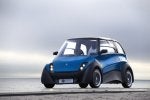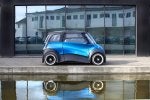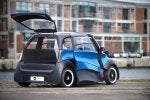Basing their extended-range electric QBEAK around a bio-methanol-utilizing fuel cell, a consortium of Danish companies working on the Modular Energy Carrier concept (MECc) has just received government funding to develop a low-cost, high-efficiency car.
Yes, without specifying projected price, the group boldly states the range-extended version of the electric car will overcome several objections surrounding EV acceptance today by offering affordable range up to 500 miles and potentially gas-pump-quick refueling time.

The methanol fuel can be derived from either biomass or waste products such as glycerin. The methanol/water mix is said to be as simple to transport as other fuels.
The all-electric version of the ECOmove QBEAK is due this fall and the extended-range project is being managed by Insero E-Mobility .
The modular car will incorporate a High Temperature Polymer Electrolyte Membrane (HTPEM) fuel cell system developed by Serenergy – the first commercially available, low pressure, air-cooled HTPEM fuel cell system in the world.

The chassis has six "energy slots." These can accept either a battery, a fuel cell, or a methanol tank. The range-extended version will have a 2.5-kw fuel cell and tank in two slots, but more fuel cells plus tank modules can be added for longer range.
Promised benefits for this “game changer in the e-mobility industry” also include minimal pollution from emissions and potential use of existing infrastructure to refuel the vehicle like you would a regular petrol car in under three minutes.
“ECOmove has re-thought the e-car concept from scratch and they have developed an innovative means of transport setting new standards for design, usability and sustainability,” says the company. “Serenergy’s full cell products offer simple and cost-effective air-cooled fuel cell technology with high fuel flexibility and reliable fuel cell operation under extreme temperature conditions.”

The hatchback city car is quite diminutive at 9.7 feet X, 5.7 feet X 5.4 feet (3m x 1.75m x 1.63m), but offers excellent space utilization and capability to seat as many as six people entering via one of two sliding doors on either side. EV range for the non-range-extended model using six energy modules of 4.7 kwh each is 186 miles (300 km). Top speed from two in-wheel motors – 35.4 kw each, a total of 70.8 kw peak – is up to 75 mph (120 kph). The bare vehicle without energy modules weighs just 937 pounds (425 kg).

Modular batteries can be added to adjust range up to 186 miles without a range extending fuel cell.
Waste heat from the fuel cell stack will be used for cabin heating or cooling, says ECOmove, and longer life for the batteries is also promised due to a more stable state of charge.
The consortium has already introduced a small EcoMotion fuel-cell truck to market, and the QBEAK people mover will be a “voluntary plug in.” This means energy can come from plugging into the grid during off-peak hours, or when convenience is wanted, it can be quickly topped off with renewable bio-methanol.

Bio-methanol is said to already have good availability, and it’s been estimated an existing fuel pump can be converted to dispense it for around $18,400 (€15,000). Methanol is also considered less bio-hazardous than petrochemicals if it's spilled.
Funding is coming via the Energy Technology Development and Demonstration Program ( EDDP ), which supports technological development intended to make Denmark independent of fossil fuels by 2050.
For more info, be sure to click on the relevant links provided.
ECOmove press release , plugineurope.com
Yes, without specifying projected price, the group boldly states the range-extended version of the electric car will overcome several objections surrounding EV acceptance today by offering affordable range up to 500 miles and potentially gas-pump-quick refueling time.

The methanol fuel can be derived from either biomass or waste products such as glycerin. The methanol/water mix is said to be as simple to transport as other fuels.
The all-electric version of the ECOmove QBEAK is due this fall and the extended-range project is being managed by Insero E-Mobility .
The modular car will incorporate a High Temperature Polymer Electrolyte Membrane (HTPEM) fuel cell system developed by Serenergy – the first commercially available, low pressure, air-cooled HTPEM fuel cell system in the world.

The chassis has six "energy slots." These can accept either a battery, a fuel cell, or a methanol tank. The range-extended version will have a 2.5-kw fuel cell and tank in two slots, but more fuel cells plus tank modules can be added for longer range.
Promised benefits for this “game changer in the e-mobility industry” also include minimal pollution from emissions and potential use of existing infrastructure to refuel the vehicle like you would a regular petrol car in under three minutes.
“ECOmove has re-thought the e-car concept from scratch and they have developed an innovative means of transport setting new standards for design, usability and sustainability,” says the company. “Serenergy’s full cell products offer simple and cost-effective air-cooled fuel cell technology with high fuel flexibility and reliable fuel cell operation under extreme temperature conditions.”

The hatchback city car is quite diminutive at 9.7 feet X, 5.7 feet X 5.4 feet (3m x 1.75m x 1.63m), but offers excellent space utilization and capability to seat as many as six people entering via one of two sliding doors on either side. EV range for the non-range-extended model using six energy modules of 4.7 kwh each is 186 miles (300 km). Top speed from two in-wheel motors – 35.4 kw each, a total of 70.8 kw peak – is up to 75 mph (120 kph). The bare vehicle without energy modules weighs just 937 pounds (425 kg).

Modular batteries can be added to adjust range up to 186 miles without a range extending fuel cell.
Waste heat from the fuel cell stack will be used for cabin heating or cooling, says ECOmove, and longer life for the batteries is also promised due to a more stable state of charge.
The consortium has already introduced a small EcoMotion fuel-cell truck to market, and the QBEAK people mover will be a “voluntary plug in.” This means energy can come from plugging into the grid during off-peak hours, or when convenience is wanted, it can be quickly topped off with renewable bio-methanol.

Bio-methanol is said to already have good availability, and it’s been estimated an existing fuel pump can be converted to dispense it for around $18,400 (€15,000). Methanol is also considered less bio-hazardous than petrochemicals if it's spilled.
Funding is coming via the Energy Technology Development and Demonstration Program ( EDDP ), which supports technological development intended to make Denmark independent of fossil fuels by 2050.
For more info, be sure to click on the relevant links provided.
ECOmove press release , plugineurope.com









